Australian
Natural Adventures
Custom
Australia, New Zealand & Pacific tours and travel

BARKBUSTERS

AUSTRALIA
This
tour has been arranged to enable Barkbuster conferees to see a bit
more of Australia while there, especially Australia's unique wildlife
and the Great Barrier Reef. We've arranged the tour in two modules,
one before the conference and one after. Immediately after the conference
there's a rest day, but for those interested in birds and marine life
there is a regularly scheduled pelagic trip departing Wollongong available.
While not part of the two tour modules per se, we can make the bookings
for you to guarantee your space.
The
first part of the tour begins in Cairns, and ends in Sydney. The second
begins in Sydney and ends in Melbourne.
Day
1 – Sunday, September 13: Home City / Los Angeles / Lost In
Space
Depart your home city for Los
Angeles airport, then depart late this evening on your flight
to Sydney. Australia begins when you step aboard your Qantas flight. The Australian style is apparent—easy going, casually
efficient and very friendly. Qantas is known for its food and service,
so sit back and enjoy the meal and a movie. The seats have individual
video screens, and a range of entertainment options, and the movies
can be Tivo’d if you need to take a break. However, it will
be late before a meal is served, especially for those comnig from
the east, it is a long flight, and so we personally recommend getting
something to eat prior to the flight, placing a Do Not Disturb notice
on your seat back and trying to get some sleep. While there are several
food outlets in the all gate areas at LAX, the best selection is at
the rear of the Tom Bradley International Terminal, at the head of
the horseshoe that is LAX (see
map) and adjacent to Terminal 4. With Qantas, Brisbane flights
depart from Terminal 4, and Sydney flights from the Tom Bradley.
(*D)
flight. The Australian style is apparent—easy going, casually
efficient and very friendly. Qantas is known for its food and service,
so sit back and enjoy the meal and a movie. The seats have individual
video screens, and a range of entertainment options, and the movies
can be Tivo’d if you need to take a break. However, it will
be late before a meal is served, especially for those comnig from
the east, it is a long flight, and so we personally recommend getting
something to eat prior to the flight, placing a Do Not Disturb notice
on your seat back and trying to get some sleep. While there are several
food outlets in the all gate areas at LAX, the best selection is at
the rear of the Tom Bradley International Terminal, at the head of
the horseshoe that is LAX (see
map) and adjacent to Terminal 4. With Qantas, Brisbane flights
depart from Terminal 4, and Sydney flights from the Tom Bradley.
(*D)
Day 2 – Monday, September 14: Lost In Space
Lose today due to the International Dateline, but regain it on your
return journey.
Day
3 – Tuesday, September 15: LIS / Sydney /Cairns
 Arrive in Sydney (or Brisbane) early this morning, pass through customs
and immigration, after which you change to the domestic terminal for
your 9.15am Qantas flight 924 to Cairns. On arrival we are met and
transferred to our hotel on the Esplanade, looking out over the Coral
Sea. Although our rooms may not be ready, we are able to leave your
bags there. The rest of the day is free to explore Cairns, a pretty
and small tropical city. Our hotel fronts onto the best part of the
Esplanade for shorebirds, ranging from big pelicans to small peeps.
Tonight we have a welcome dinner to introduce everyone, and to learn
more of our plans over the next few days.
(*B,L)
Arrive in Sydney (or Brisbane) early this morning, pass through customs
and immigration, after which you change to the domestic terminal for
your 9.15am Qantas flight 924 to Cairns. On arrival we are met and
transferred to our hotel on the Esplanade, looking out over the Coral
Sea. Although our rooms may not be ready, we are able to leave your
bags there. The rest of the day is free to explore Cairns, a pretty
and small tropical city. Our hotel fronts onto the best part of the
Esplanade for shorebirds, ranging from big pelicans to small peeps.
Tonight we have a welcome dinner to introduce everyone, and to learn
more of our plans over the next few days.
(*B,L)
Day
4 – Wednesday September 16: Great Barrier Reef
Today explore one of the natural wonders of the world—Australia’s
Great Barrier Reef, a series of reefs extending for about 1,250 miles
along the coast of Queensland, nearly to Papua 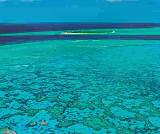 New
Guinea. On our trip today we experience two important features—a
coral inner-shelf reef, and the sandy vegetated cay formed on one
end. Michaelmas Reef lies about 22
New
Guinea. On our trip today we experience two important features—a
coral inner-shelf reef, and the sandy vegetated cay formed on one
end. Michaelmas Reef lies about 22  miles
off the coast just north of Cairns, with Michaelmas
Cay on its southern tip. It is an important seabird rookery, which
becomes apparent as we approach the mass of birds swirling constantly
above the cay. The four primary species are Crested, Lesser-crested
and Sooty Terns, and Common Noddy. Lesser Frigatebirds are usually
present, occasionally Greater, as are Silver Gulls, Brown Boobies
and Ruddy Turnstones. The cay, most of which is off limits, is a National
Park within the Great Barrier Reef Marine Park. However, the birds
are very tolerant of visitors and stand thickly along the beach, allowing
us to approach them within a few yards and less. Immediately offshore
in waist-deep water, the first of the corals can be seen. For those
not used to snorkeling, there is no easier introduction—just
walk up to your waist, and bend over. Brillian
miles
off the coast just north of Cairns, with Michaelmas
Cay on its southern tip. It is an important seabird rookery, which
becomes apparent as we approach the mass of birds swirling constantly
above the cay. The four primary species are Crested, Lesser-crested
and Sooty Terns, and Common Noddy. Lesser Frigatebirds are usually
present, occasionally Greater, as are Silver Gulls, Brown Boobies
and Ruddy Turnstones. The cay, most of which is off limits, is a National
Park within the Great Barrier Reef Marine Park. However, the birds
are very tolerant of visitors and stand thickly along the beach, allowing
us to approach them within a few yards and less. Immediately offshore
in waist-deep water, the first of the corals can be seen. For those
not used to snorkeling, there is no easier introduction—just
walk up to your waist, and bend over. Brillian tly
colored fish, giant clams, beche de mer and coral outcrops can all
be seen. Easy swimming in shal
tly
colored fish, giant clams, beche de mer and coral outcrops can all
be seen. Easy swimming in shal low
water brings you over coral “bombies,” heads of coral
with their assortment of fishes, and hard and soft corals. Parrot
fish glean algae from the coral, and small and medium predators search
for food. Schools of fish twist and flash between the outcrops. An
occasional sea turtle may be seen. We can also glide around the coral
in a glass-bottomed boat, dry and with our ordinary cameras, while
a marine biologist describes the species seen and some of the processes
at work. There are guided snorkel tours, and certified divers have
the option of two dives. On our trip out, one of the marine biologists
explains the development of this and other reef systems and gives
us an introduction to many of the animal species that you see. Lunch
is a tropical smorgasbord. In the afternoon we return to Cairns, under
sail if the winds are right. (B,L)
low
water brings you over coral “bombies,” heads of coral
with their assortment of fishes, and hard and soft corals. Parrot
fish glean algae from the coral, and small and medium predators search
for food. Schools of fish twist and flash between the outcrops. An
occasional sea turtle may be seen. We can also glide around the coral
in a glass-bottomed boat, dry and with our ordinary cameras, while
a marine biologist describes the species seen and some of the processes
at work. There are guided snorkel tours, and certified divers have
the option of two dives. On our trip out, one of the marine biologists
explains the development of this and other reef systems and gives
us an introduction to many of the animal species that you see. Lunch
is a tropical smorgasbord. In the afternoon we return to Cairns, under
sail if the winds are right. (B,L)
Day 5 – Thursday, September 17: Cairns /Atherton Tablelands
We depart Cairns this morning with our guide for the next three days,
Alan Gillanders. Alan is an expert naturalist who lives on the Atherton
Tablelands; in previous lives he worked as a teacher and for the Queensland
National Parks Service. We first head north a
north a long
the scenic Captain Cook Highway to Mossman
Gorge, where a walk in this pristine lowland rainforest introduces
us to this complex habitat. The Daintree area is home to the world’s
oldest living flowering plants, dating from early in the Age of Dinosaurs,
and we’ll see some of these. After the gorge we continue to
the Daintree River, where we take a one hour small boat wildlife cruise.
We’ll see a number of birds including kingfishers, most likely
frit bats, but especially the large saltwater crocodiles, some over
14ft long, that inhabit the river. We then head up into the foothills
behind the coast, and notice the vegetation turn from lush rainforest
to dry outback. Depending
long
the scenic Captain Cook Highway to Mossman
Gorge, where a walk in this pristine lowland rainforest introduces
us to this complex habitat. The Daintree area is home to the world’s
oldest living flowering plants, dating from early in the Age of Dinosaurs,
and we’ll see some of these. After the gorge we continue to
the Daintree River, where we take a one hour small boat wildlife cruise.
We’ll see a number of birds including kingfishers, most likely
frit bats, but especially the large saltwater crocodiles, some over
14ft long, that inhabit the river. We then head up into the foothills
behind the coast, and notice the vegetation turn from lush rainforest
to dry outback. Depending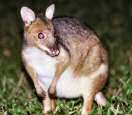 on recent activity we’ll make several stops along the way to
look for wildlife, i
on recent activity we’ll make several stops along the way to
look for wildlife, i ncluding
for the gray kangaroos that frequent the Mareeba golf course. With
sunset approaching we’ll find ourselves waiting at the rim of
a small extinct volcano, waiting for Sarus Cranes and Brolgas to fly
in overhead and wheel down into the swamp at the bottom to roost overnight.
Their circling, dangling flight and contact calls backed by the setting
sun are a spectacle to remember . Our accommodation for the next two
nights is a small ecolodge in the rainforest, with a considerable
amount of resident wildlife. Tonight we’ll watch as pademelons
– small rainforest wallabies – come out onto the grass
by the dozens to feed, and later this evening we may be visited by
sugar gliders.
(B,D)
ncluding
for the gray kangaroos that frequent the Mareeba golf course. With
sunset approaching we’ll find ourselves waiting at the rim of
a small extinct volcano, waiting for Sarus Cranes and Brolgas to fly
in overhead and wheel down into the swamp at the bottom to roost overnight.
Their circling, dangling flight and contact calls backed by the setting
sun are a spectacle to remember . Our accommodation for the next two
nights is a small ecolodge in the rainforest, with a considerable
amount of resident wildlife. Tonight we’ll watch as pademelons
– small rainforest wallabies – come out onto the grass
by the dozens to feed, and later this evening we may be visited by
sugar gliders.
(B,D)
Day
6 – Friday, September 18: Atherton Tablelands
As he lives nearby Alan knows this area very well, and so as well
as gaining an understanding of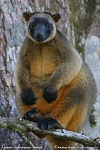 this unique rainforest area, you will look for platypus, musky rat-kangaroos,
birds and many others. The Curtain Fig and Cathedral figs are both
spectacular trees, and the large Red
this unique rainforest area, you will look for platypus, musky rat-kangaroos,
birds and many others. The Curtain Fig and Cathedral figs are both
spectacular trees, and the large Red  Cedar
at Gadgarra shows how impressive these trees can be. The walk around
Lake Eacham is very enjoyable, and may give good views of large Scrub
Pythons sunning on the lakeside grass, eels, and other wildlife. The
day's itinerary will be decided in part by Alan's experience, everyone’s
interests, and seasonal wildlife activity. After dinner you will spend
a couple of hours spotlighting for nocturnal wildlife, including the
attractive rare and endemic possums that occur only here, owls, with
luck the 8 to 10 inch leg and quite bizarre leaf-tailed gecko, and
especially the strange Lumholtz tree kangaroo, which lives in the
trees and not on the ground like other kangaroos. Alan is particularly
expert at finding these. (B,D)
Cedar
at Gadgarra shows how impressive these trees can be. The walk around
Lake Eacham is very enjoyable, and may give good views of large Scrub
Pythons sunning on the lakeside grass, eels, and other wildlife. The
day's itinerary will be decided in part by Alan's experience, everyone’s
interests, and seasonal wildlife activity. After dinner you will spend
a couple of hours spotlighting for nocturnal wildlife, including the
attractive rare and endemic possums that occur only here, owls, with
luck the 8 to 10 inch leg and quite bizarre leaf-tailed gecko, and
especially the strange Lumholtz tree kangaroo, which lives in the
trees and not on the ground like other kangaroos. Alan is particularly
expert at finding these. (B,D)
Day
7 – Saturday, September 19: Atherton Tablelands / Cairns / Sydney
A fter
a early morning wildlife search in the lodge area we head back towards
Mareeba, bu
fter
a early morning wildlife search in the lodge area we head back towards
Mareeba, bu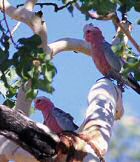 t
detour inland to Granite Gorge. This dry area has a good selection
of dry country wildlife, especially parrots and bowerbirds. However,
the main attraction here is the population of rock wallabies, which
have become accustomed to human presence and although wild, are quite
tame. They are attractive small wallabies, and it’s usual to
see joeys – pouch young – hopping in and out of pouches,
or poking their heads and often their legs out. Continue to Kuranda,
where we are guided through the wonderful Butterfly Sanctuary; brilliantly
colored large butterflies may land on our shoulders, and rest a foot
or two away on l
t
detour inland to Granite Gorge. This dry area has a good selection
of dry country wildlife, especially parrots and bowerbirds. However,
the main attraction here is the population of rock wallabies, which
have become accustomed to human presence and although wild, are quite
tame. They are attractive small wallabies, and it’s usual to
see joeys – pouch young – hopping in and out of pouches,
or poking their heads and often their legs out. Continue to Kuranda,
where we are guided through the wonderful Butterfly Sanctuary; brilliantly
colored large butterflies may land on our shoulders, and rest a foot
or two away on l eaves
and railings. We then head down the mountainside, from 1000ft above
sea-level to the coast on the Skyrail,
a cable car that offers spectacular views o
eaves
and railings. We then head down the mountainside, from 1000ft above
sea-level to the coast on the Skyrail,
a cable car that offers spectacular views o ut
over the Coral Sea as it skims the treetops. There are two boardwalks
to stop at on the way down, enabling us to walk in the canopy. At
the bottom we are met once again by Alan who takes us to the airport
for our 5.15pm Qantas flight 927 to Sydney, arriving at 8.15pm. We
are met and transferred to our hotel, overlooking Darling Harbour
and close to the new Sydney
Aquarium, for the next two nights. (B*D)
ut
over the Coral Sea as it skims the treetops. There are two boardwalks
to stop at on the way down, enabling us to walk in the canopy. At
the bottom we are met once again by Alan who takes us to the airport
for our 5.15pm Qantas flight 927 to Sydney, arriving at 8.15pm. We
are met and transferred to our hotel, overlooking Darling Harbour
and close to the new Sydney
Aquarium, for the next two nights. (B*D)
Day
8 – Sunday, September 20: Blue Mountains
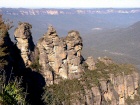 The Blue
Mountains are an extremely scenic area of Australian bush just
inland from Sydney, and a designated World Heritage Area, and our
focus today. We start the tour from our hotel at 8.30am
The Blue
Mountains are an extremely scenic area of Australian bush just
inland from Sydney, and a designated World Heritage Area, and our
focus today. We start the tour from our hotel at 8.30am for a full day out to the Blue Mountains. After traveling through
Sydney we’ll take morning tea overlooking the tranquil Nepean
River, then we head up the mountains to Evans Lookout, the best place
to view the wilderness of the Blue Mountains. At Wentworth Falls we
take a relaxing walk to the breathtaking falls. Lunch is taken in
Leura, a picturesque village in the mountains. After lunch we visit
K
for a full day out to the Blue Mountains. After traveling through
Sydney we’ll take morning tea overlooking the tranquil Nepean
River, then we head up the mountains to Evans Lookout, the best place
to view the wilderness of the Blue Mountains. At Wentworth Falls we
take a relaxing walk to the breathtaking falls. Lunch is taken in
Leura, a picturesque village in the mountains. After lunch we visit
K atoomba
and the Katoomba Waterfall, and the famous Three Sisters rock formation.
You may enjoy an optional ride on the Scenic Railway to the forest
floor for a walk, then ascend back by the world’s steepest cablecar.
We return to Homebush, site of the Sydney Olympics, to board a fast
ferry back to Circular Quay. The evening is free to discover Sydney’s
excellent dining scene. (B,L)
atoomba
and the Katoomba Waterfall, and the famous Three Sisters rock formation.
You may enjoy an optional ride on the Scenic Railway to the forest
floor for a walk, then ascend back by the world’s steepest cablecar.
We return to Homebush, site of the Sydney Olympics, to board a fast
ferry back to Circular Quay. The evening is free to discover Sydney’s
excellent dining scene. (B,L)
Day
9 – Monday, September 21: Sydney
The pre-tour ends after breakfast this morning, and today is available
to look around Sydney prior to heading down to Wollongong for the
conference. Sydney is a wonderfully cosmopolitan city. In addition
to g reat
shops to buy the needed souvenirs and gifts, just a short walk is
the Botanic
Gardens and the Domain, which has good views of the har
reat
shops to buy the needed souvenirs and gifts, just a short walk is
the Botanic
Gardens and the Domain, which has good views of the har bor,
an abundant bird life, and a colony of huge grey fruit-bats, whose
wingspans are approximately three feet. The
Australian Museum, with its impressive collection of Aboriginal
artifacts and art, is close by, and you may wish to take a guided
tour of the Opera House; tours leave on the half hour from 9.30am
until 4.45pm. You could easily time this so the boys can see you -
more or less - from the top of the bridge, and you could nominally
photograph them. However, this may also be a good time to think about
opals. Sydney is a good place to buy opals, and both Art
of Opal and Altmann
& Cherny have a
bor,
an abundant bird life, and a colony of huge grey fruit-bats, whose
wingspans are approximately three feet. The
Australian Museum, with its impressive collection of Aboriginal
artifacts and art, is close by, and you may wish to take a guided
tour of the Opera House; tours leave on the half hour from 9.30am
until 4.45pm. You could easily time this so the boys can see you -
more or less - from the top of the bridge, and you could nominally
photograph them. However, this may also be a good time to think about
opals. Sydney is a good place to buy opals, and both Art
of Opal and Altmann
& Cherny have a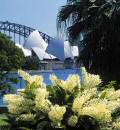 good range of loose and mounted opals in all price ranges. Both have
opal displays, and information about mining. A visit to the Opera
House can be followed by dinner at the fine dining restaurant, or
outside at one of the several outdorro cafes. Everything is within
walk
good range of loose and mounted opals in all price ranges. Both have
opal displays, and information about mining. A visit to the Opera
House can be followed by dinner at the fine dining restaurant, or
outside at one of the several outdorro cafes. Everything is within
walk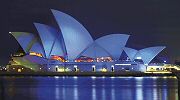 ing
distance of your hotel, although Sydney is extremely well-serviced
by buses and the underground. Lunch can be taken on a cruise on the
harbor, with views of the Opera House and Harbour Bridge, as well
as the boats and ferries of what is often called the most beautiful
city harbor in the world. A ten minute walk away is The
Rocks, the historical heart of Sydney and adjacent to Circular
Quay and Sydney Harbour; many of the buildings are convict-built.
As well as a good range of interesting shops, some of Sydney's oldest
and most colorful pubs are found here. Those interested can take an
optional 90 minute guided walk around The Rocks, learning of Sydney’s,
and Australia’s, early history.
(B)
ing
distance of your hotel, although Sydney is extremely well-serviced
by buses and the underground. Lunch can be taken on a cruise on the
harbor, with views of the Opera House and Harbour Bridge, as well
as the boats and ferries of what is often called the most beautiful
city harbor in the world. A ten minute walk away is The
Rocks, the historical heart of Sydney and adjacent to Circular
Quay and Sydney Harbour; many of the buildings are convict-built.
As well as a good range of interesting shops, some of Sydney's oldest
and most colorful pubs are found here. Those interested can take an
optional 90 minute guided walk around The Rocks, learning of Sydney’s,
and Australia’s, early history.
(B)
We
will arrange a transfer vehicle from Sydney to Wollongong departing
at 5pm; Conferees not particpating in the pre-conference tour are
welcome to use this transfer as well. Please note this is not
included in the tour but will be at additional expense. Alternatively
trains depart Central Station regularly for Wollongong and the fare
is approximately $AU10. As this is a commuter line trains get
full weekdays at peak hours; look for a departure that stops at selected
stations only for a shorter trip such as the 5.12 or 5.42pm. It's
a scenic ride, so choose a seat upstairs on the left side of the train.
Day
10 – Tuesday, September 22: Wollongong
B egin
the Barkbusters conference today.
egin
the Barkbusters conference today.
Days
11 and 12 – Wednesday, September 23 & Thursday, September
24: Wollongong
Your Conference continues.
Day 13 –Friday, September 25: Wollongong
Today is the Garden Party at the home of Sylvia and Danny Wilson,
Barkbusters founders. Those returning to the US at this point will
return to Sydney and overnight (depending on flight time; it may be
possible to overnight in Wollongong). Those participating in the southern
portion of our nature tour will stay in Wollongong.
Day
14– Saturday, September 26: Wollongong
Today there are three options for today.
Option 1: Pelagic and whale trip.
The waters offshore from Wollongong are a haven for pelagic seabirds,
a nd
in September also see migrating whales passing by. A full list of
the speci
nd
in September also see migrating whales passing by. A full list of
the speci es
seen on the 2008 September trip can be seen here: www.sossa-international.org/Pages/Pelagic%20Reports/Sept2008.htm,
but highlights of the 25 species seen included nine species of albatross,
five species of shearwaters, two petrels and fairy prion. Another
20 or so species have also been seen over the years. Humpback, Antarctic
Minke and Pygmy Killer Whales, and Common Dolphins are frequently
seen on September trips. The trip leaves at 7am and returns about
4pm. Cost is approximately $75.
es
seen on the 2008 September trip can be seen here: www.sossa-international.org/Pages/Pelagic%20Reports/Sept2008.htm,
but highlights of the 25 species seen included nine species of albatross,
five species of shearwaters, two petrels and fairy prion. Another
20 or so species have also been seen over the years. Humpback, Antarctic
Minke and Pygmy Killer Whales, and Common Dolphins are frequently
seen on September trips. The trip leaves at 7am and returns about
4pm. Cost is approximately $75.
Option 2: Wollongong has a strong
art presence, many interesting private galleries and shops, and nice
parks. A full and relaxing day can be had exploring this city, especially
the historic downtown precinct. The City Gallery is in the heart of
the city, forming part of this cultural precinct. It is recognized
as the best regional gallery in Australia for its innovative and thought-provoking
exhibitions and programs.
Option 3: Monday arrivers, and others, may
wish to explore Sydney, a little over an hour away.
Day 15 – Sunday, September 27: Wollongong/ Sydney /
Melbourne
 We transfer back to Sydney airport for our 9am Qantas flight 419 south
to Melbourne, arriving at 10.30am. If we can’t check into our
centrally located hotel we will be able to leave our bags until check-in.
About 2.45pm we are picked up to travel south to Phillip Island, about
1.5 hours away. As the sun sets we watch Fairy Penguins waddle up
the beach, straight past our feet and into their burrows, after a
days’ foraging at sea. A Ranger is at hand to answer questions.
This is a wonderful wildlife experience, and you are very close to
these delightful creatures. Prior to watching the penguins we’ll
spend some time in the interpretive center to learn more about the
life of these, the world’s smallest penguin.
We transfer back to Sydney airport for our 9am Qantas flight 419 south
to Melbourne, arriving at 10.30am. If we can’t check into our
centrally located hotel we will be able to leave our bags until check-in.
About 2.45pm we are picked up to travel south to Phillip Island, about
1.5 hours away. As the sun sets we watch Fairy Penguins waddle up
the beach, straight past our feet and into their burrows, after a
days’ foraging at sea. A Ranger is at hand to answer questions.
This is a wonderful wildlife experience, and you are very close to
these delightful creatures. Prior to watching the penguins we’ll
spend some time in the interpretive center to learn more about the
life of these, the world’s smallest penguin.
 Day
16 – Monday, September 28: Melbourne / Brisbane Ranges area/
Melbourne
Day
16 – Monday, September 28: Melbourne / Brisbane Ranges area/
Melbourne
Today is bound to be a highlight of our entire trip. This morning
we are picked up for our private o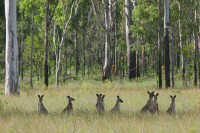 uting
to the open eucalyptus forests and hills just west of Melbourne. Our
guide has been following and studying koalas here for many years,
and knows them personally. We’ll be looking for these iconic
Australian animals, as well as kangaroos, wallabies, emus and much
else; parrots are common, from large white cockatoos to small and
colorful red-rumped parrots. After l
uting
to the open eucalyptus forests and hills just west of Melbourne. Our
guide has been following and studying koalas here for many years,
and knows them personally. We’ll be looking for these iconic
Australian animals, as well as kangaroos, wallabies, emus and much
else; parrots are common, from large white cockatoos to small and
colorful red-rumped parrots. After l unch
we head just a little north, to the Dingo
Discovery Sanctuary and Research Centre. Here Lyn and Peter Watson
have set up a sanctuary and research area for dingoes, and we’ll
meet them, learn of their work, and meet some of their charges. As
well as being dingo experts both Peter and Lyn are national and international
dog judges. After our return to Melbourne we enjoy a farewell dinner.
(B,L,D)
unch
we head just a little north, to the Dingo
Discovery Sanctuary and Research Centre. Here Lyn and Peter Watson
have set up a sanctuary and research area for dingoes, and we’ll
meet them, learn of their work, and meet some of their charges. As
well as being dingo experts both Peter and Lyn are national and international
dog judges. After our return to Melbourne we enjoy a farewell dinner.
(B,L,D)
Day
17 – Tuesday, September 29: Melbourne / Los Angeles
Sadly we leave Australia today and fly back to Los Angeles on Qantas
flight 93 at 10.15am, but taking many memories and permanent souvenirs.
You are transferred to the airport for your morning flight back to
the US (some participants may need to fly back to Sydney if they are
not ticketed to depart from Melbourne). Due to the International Dateline,
we arrive back into Los Angeles at 7.30am this same morning, in plenty
of time to catch our flights to our home cities. (B,*M,*B)
(B: Breakfast;
L: Lunch; D: Dinner; M: Meal; S: Snack; * in flight meal)
<<< back
to nature itineraries